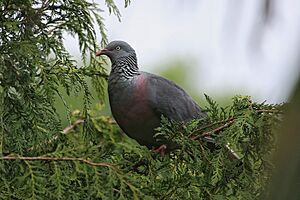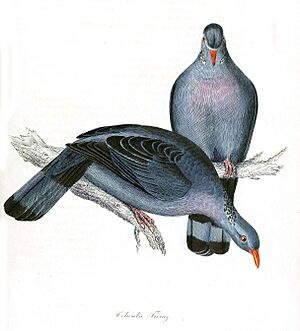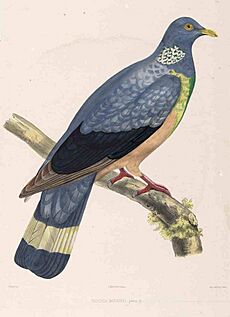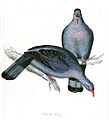Trocaz pigeon facts for kids
Quick facts for kids Trocaz pigeon |
|
|---|---|
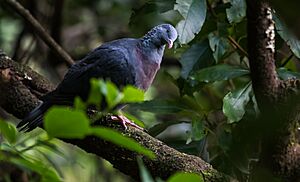 |
|
| Conservation status | |
| Scientific classification | |
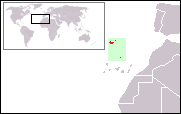 |
|
| Location map | |
| Synonyms | |
|
The trocaz pigeon (Columba trocaz), also called the Madeira laurel pigeon, is a special type of pigeon. It lives only on the island of Madeira, Portugal. This pigeon is mostly grey with a pink chest. It has a shiny, silver patch on its neck. This helps tell it apart from its relative, the common wood pigeon. The trocaz pigeon's call is a unique six-note cooing sound. It is softer and lower than the wood pigeon's call. Even though it looks big and has a long tail, this pigeon flies very fast and straight.
The trocaz pigeon is rare and lives in laurisilva forests. It builds a simple nest of twigs and lays one white egg. Its numbers dropped a lot after people settled on the Madeira archipelago. It even disappeared completely from Porto Santo Island. The main reason for this was losing its home as forests were cut down. Hunting and rats eating their eggs also caused problems. But now, the laurel forests are protected. Hunting is also banned. This has helped the pigeon's numbers grow. So, it is no longer in danger.
Contents
Meet the Trocaz Pigeon
The trocaz pigeon is a dark grey bird. It is about 40 to 45 centimeters (16 to 18 inches) long. Its wings can spread 68 to 74 centimeters (27 to 29 inches) wide. Its upper back has a purple shine. This turns green on the back of its neck. The sides of its neck have silver-white patterns. Its tail is blackish with a wide, light grey band. The main flight feathers are black. The top part of its chest is pink. Its eye is yellow, and its beak has a yellow tip and a reddish-purple base. Its legs are red.
Male and female trocaz pigeons look similar. Young pigeons have browner feathers. They have little or no silver patch on their neck. Their closed wings look scaly. This is because of their pale, buff-colored feather edges.
Sounds and Flight
The trocaz pigeon's voice is softer and deeper. It is not as loud as the common wood pigeon's call. It usually has six parts. The middle two notes are longer and stronger. It sounds like uh-uh hrooh-hrooh ho-ho. When it flies, it looks heavy and has a large tail. But it flies quickly and directly.
Comparing with Other Pigeons
The common wood pigeon used to have a type that lived in Madeira. It was called Columba palumbus maderensis. This pigeon was lighter in color than the trocaz pigeon. It had white patches on its wings. It also had more green shine on its neck. But this type died out before 1924.
Bolle's pigeon looks more like the trocaz pigeon. But it does not have the whitish neck patch. Its chest is also more pink. However, Bolle's pigeon lives only in the Canary Islands. So, they do not live in the same places. The only other pigeon on Madeira is the feral pigeon. This pigeon is thinner and has pointier wings. Its tail is much smaller. It often has dark marks on its wings and flies lighter.
Pigeon Family Tree
The Columba group is the biggest in the pigeon family. It is found all over the world. These pigeons are usually light grey or brown. They often have white marks on their head or neck. They might also have shiny green or purple patches on their neck and chest.
One group within Columba includes the common wood pigeon. It also includes Bolle's pigeon, the trocaz pigeon, and the African Afep pigeon. Bolle's and trocaz pigeons live only on the Macaronesian islands. Scientists think they came from wood pigeons that got separated on these islands.
The islands of the Canaries, Azores, and Madeira were formed by volcanoes. They were never connected to a continent. Madeira started forming millions of years ago. It was mostly complete by 700,000 years ago. Over time, wood pigeons landed on these islands. They then changed and became unique to each island.
The trocaz pigeon was officially named in 1829. This was done by Karl Heineken. He was a German doctor and bird expert living on Madeira. He saw that it was different from the local wood pigeon. He suggested calling the new species "trocaz," its local name. Trocaz comes from a Latin word meaning "collar." This refers to the bird's colored neck patches. The trocaz pigeon is a unique species. In the past, Bolle's pigeon was sometimes thought to be a type of trocaz pigeon.
Where Trocaz Pigeons Live
The trocaz pigeon lives only on the main island of Madeira. This island is mountainous and has a subtropical climate. It used to live on nearby Porto Santo Island too. It mostly lives on the northern slopes of the mountains. But some are found in the south where laurel forests still exist.
Its natural home is tall laurisilva forest. These forests are often covered in clouds. They have trees like laurel, Ocotea foetens, Madeira mahogany, and Canary laurel. The trocaz pigeon likes old, untouched forests best. But it also uses younger forests for food. It even visits farms, especially when fruit is scarce. Most pigeons live below 1,000 meters (3,300 feet). They prefer steep, rocky slopes with streams. These areas often have large dead laurel trees and lots of tree heath. These pigeons move around a lot between different areas during the year.
Trocaz Pigeon Life and Habits
Reproduction and Nesting
Pigeons can start having babies when they are one year old. They nest all year, but mostly from February to June. The male pigeon's courtship displays are like those of the common wood pigeon. The male flies up quickly. He claps his wings loudly. Then he glides down with his wings and tail spread out. He might do this two or three times before landing.
On the ground, the male bows. He puffs up his neck to show off his shiny neck patches. He also raises and fans his tail, then closes it. He usually makes calls during this display. The nest is a typical pigeon nest. It is a simple structure made of twigs and grasses. It is usually placed high in a tree in a thick forest. The female lays one, rarely two, smooth white eggs. However, no nest has ever been found with two chicks. The eggs are 3.0 to 5.0 centimeters (1.2 to 2.0 inches) in size. They hatch in 19 to 20 days. The young can fly in 28 days. They are ready to live on their own within eight weeks.
What Trocaz Pigeons Eat
The trocaz pigeon eats only plants. Almost 60% of its diet is fruit. Most of the rest is leaves. Only about 1% is flowers. They often eat fruits from Til, Azores Laurel, and Persea indica. They also eat fruits and leaves from small-leaved holly. Most seeds pass through their body whole. But seeds from Azores Laurel are usually damaged.
Fruit is their main food in autumn and winter when it is easy to find. They eat leaves in spring and summer when fruits are scarce. In one study, 27% of the leaves they ate were from native trees. These were mostly Small-leaved Holly. 61% were from herbs and shrubs. Almost 10% were from introduced trees, like apples and peaches.
These pigeons will also eat in farm areas. Cabbage is the most common crop they eat. Pigeon droppings from farms have few native plants. Samples from forests have few crop plants. This means some pigeons might focus on eating crops. Eating in farm areas is most common in winter. This is when fruit is easy to find. So, it seems they do not leave the forest because they lack natural food. They just take advantage of food when they move through nearby forests. However, if there is not much Til or Azores Laurel fruit, many pigeons might leave the forest. They will then eat cabbage, flowering cherries, and vine shoots. Rats also compete with pigeons for food in some parts of the island.
Saving the Trocaz Pigeon
The trocaz pigeon used to live on both Madeira and Porto Santo Island. It was very common when people first arrived. But it disappeared from Porto Santo. By 1986, its numbers had dropped to about 2,700 birds. Hunting was banned that year. Now, there are between 7,500 and 10,000 pigeons. They live in about 160 square kilometers (62 square miles) of suitable forest. The loss of pigeons on both islands was mostly due to deforestation. Forests were cut down for wood and to create farmland.
Stopping farm animals from entering the native forest helps the forest grow back. This creates more homes for the pigeons. Some illegal hunting and poisoning still happen. This is because the pigeons can damage crops. The government even allowed a controlled hunt in 2004. Perhaps the biggest problem for the pigeon's growth is predators. Introduced black rats eat their eggs and young.
The Madeira Nature Park has a plan to help the trocaz pigeon. They hope that teaching people and using bird scarers will reduce harm to the birds. Because its population is growing, it is now listed as Least Concern on the IUCN Red List. This is an improvement from its Threatened status in 1988. This pigeon is protected by the European Union Birds Directive. Its laurel forests are also protected by the Habitats Directive.
Images for kids



